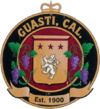Guasti, California facts for kids
Quick facts for kids
Guasti, California
|
||
|---|---|---|
|
||
| Country | ||
| State | ||
| County | ||
| Elevation | 296 m (971 ft) | |
| Time zone | UTC-8 (Pacific (PST)) | |
| • Summer (DST) | UTC-7 (PDT) | |
| ZIP code |
91761, 91743
|
|
| Area code(s) | 909 | |
| GNIS feature ID | 1660703 | |
Guasti is a small place in California. It used to be called South Cucamonga or Zucker. It is located in the Cucamonga Valley region of San Bernardino County. This area was once very important for making wine.
Contents
History of Guasti's Vineyards
Guasti was once a major area for growing grapes and making wine. This was in the Cucamonga Valley AVA region.
Early Grape Growing
In 1838, a person named Tiburcio Tapia received land from the Spanish government. He planted the first grapes in this region. This started the tradition of growing grapes here.
Later, in 1859, a rancher named John Rains changed things. He started growing crops on a large scale. Before him, people mostly raised cattle and sheep. His vineyard was bought by Isaias Hellman in the 1870s. This vineyard produced thousands of gallons of wine until World War I.
Secondo Guasti and the Italian Vineyard Company
The area really grew in the early 1900s. Secondo Guasti (1859-1927) came to Los Angeles from Italy in 1878. He worked hard and saved money. He bought a small vineyard in Glendale, CA.
After visiting the Cucamonga Valley, Guasti bought a huge piece of land. It was about eight square miles! He planted many different types of grapes there. This land became the start of his famous Italian Vineyard Company.
Building the Guasti Village
To help his workers, Secondo Guasti built a village in 1904. This village had everything the workers needed. It included a company store, an inn, a bakery, and a fire station. There was also a hotel and a post office.
Guasti's vineyard grew to 5,000 acres. It became the largest continuous vineyard in the world! He even built his own 22-mile narrow gauge railroad. This railroad helped move grapes and wine to the packing houses. One of these old stone buildings still stands today.
By 1917, the vineyards in Cucamonga-Guasti were huge. They covered over 20,000 acres. Guasti himself managed 5,000 acres. His company produced 5 million gallons of wine each year. It was known as "The Largest Vineyard in the World."
The Village Church
In 1924, Guasti brought skilled workers from Mexico and Italy. They built a church for the village. The church was designed like a 17th-century church from his hometown in Asti, Italy. It was finished two years later and is still used today. A bronze statue at the church entrance honors Secondo Guasti.
By the 1950s, many of the workers in Guasti were from Mexico. Before that, most were Italian.
Guasti Wines Today
Today, Guasti Wines still sells special wines for religious ceremonies. They sell these wines all over the world. This is done through the Joseph Filippi Winery and Vineyards.
The Filippi family has a long history in winemaking. Giovanni Filippi started his winery in 1934. His grandson, Joseph Jr., even taught about winemaking at UC Davis. The Filippis have worked to bring old vineyards back to life. They also helped the Cucamonga Valley become a recognized area for growing grapes. This means wineries can use the valley's name on their labels if they use local grapes.
Guasti's Modern Development
Guasti has now become part of the city of Ontario, California. It is located about 3.5 miles (5.6 km) east of downtown Ontario. It is also close to the Ontario International Airport.
Guasti is now located in the area with ZIP code 91761. This happened after it became part of Ontario.
In 2001, a company bought 49 acres around the historic Guasti Village. They are working with the city of Ontario to fix up the old buildings. They also plan to build new offices, a hotel, and an area for entertainment.




